
The hobo spider is a member of the family of spiders known colloquially as funnel web spiders, but not to be confused with the Australian funnel-web spider. Individuals construct a funnel-shaped structure of silk sheeting and lie in wait at the small end of the funnel for prey insects to blunder onto their webs. Hobo spiders sometimes build their webs in or around human habitations. The hobo spider lays its eggs in September and they hatch during late spring. After the male hobo spider mates it dies.

Uloboridae is a family of non-venomous spiders, known as cribellate orb weavers or hackled orb weavers. Their lack of venom glands is a secondarily evolved trait. Instead, they wrap their prey thoroughly in silk, cover it in regurgitated digestive enzymes, and then ingest the liquified body.
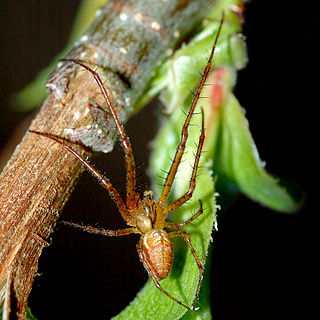
Long-jawed orb weavers or long jawed spiders (Tetragnathidae) are a family of araneomorph spiders first described by Anton Menge in 1866. They have elongated bodies, legs, and chelicerae, and build small orb webs with an open hub with few, wide-set radii and spirals with no signal line or retreat. Some species are often found in long vegetation near water.

Gasteracantha is a genus of orb-weaver spiders first named by Carl Jakob Sundevall in 1833. Species of the genus are known as spiny-backed orb-weavers, spiny orb-weavers, or spiny spiders. The females of most species are brightly colored with six prominent spines on their broad, hardened, shell-like abdomens. The name Gasteracantha is derived from the Greek gaster (γαστήρ), meaning "belly, abdomen", and akantha (άκανθα), meaning "thorn, spine". Spiny-backed orb-weavers are sometimes colloquially called "crab spiders" because of their shape, but they are not closely related to the true crab spiders. Other colloquial names for certain species include thorn spider, star spider, kite spider, or jewel spider.

Leucauge is a spider genus of long-jawed orb weavers, with over 160 species and fully pantropical distribution.
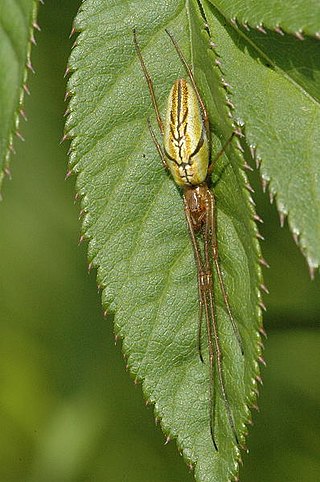
Tetragnatha is a genus of long-jawed orb-weavers found all over the world. It was first described by Pierre André Latreille in 1804, and it contains hundreds of species. Most occur in the tropics and subtropics, and many can run over water. They are commonly called stretch spiders in reference to their elongated body form and their ability to hide on blades of grass or similar elongated substrates by stretching their front legs forward and the others behind them. The name Tetragnatha is derived from Greek, tetra- a numerical prefix referring to four and gnatha meaning "jaw". Evolution to cursorial behavior occurred long ago in a few different species, the most studied being those found on the Hawaiian islands. One of the biggest and most common species is T. extensa, which has a holarctic distribution. It can be found near lakes, river banks or swamps. Large numbers of individuals can often be found in reeds, tall grass, and around minor trees and shrubs.
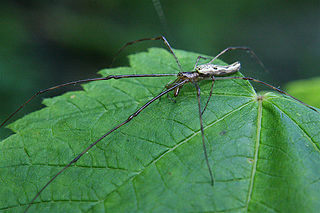
Tetragnatha elongata, the elongate stilt spider, is a spider in the family Tetragnathidae.

Tetragnatha extensa is a species of spider found across the Northern Hemisphere. It has an elongate body, up to 11 mm (0.43 in) long, and adopts a straight line posture when alarmed. It lives on low vegetation in damp areas, and feeds on flying insects which it catches in its web.
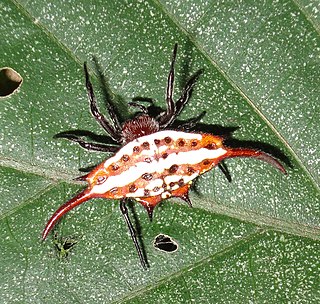
Gasteracantha versicolor, known as the long-winged kite spider, is a species of diurnal spiny orb-weaver of the family Araneidae. It is found in the tropics and sub-tropics, where it occurs in forests. It has an extensive range, from central, east and southern Africa to Madagascar.

Nephila antipodiana, also known as the batik golden web spider, is a species of golden orb-web spider discovered in 1841 by Charles Athanase Walckenaer. The species is found throughout Australia, China, Indonesia, the Philippines, and Thailand. The spider's silk contains a pyrrolidine alkaloid which serves as a chemical repellent to keep ants away from the spider's web.

Mangora acalypha, also known by its common name cricket-bat orbweaver, is a species of spider in the family Araneidae, found throughout the Palearctic realm. This species was originally described by Charles Athanase Walckenaer in 1802 as Aranea acalypha.

Tetragnatha montana, commonly known as the silver stretch spider, is a species of long-jawed orb weaver from the family Tetragnathidae that has a Palearctic distribution. It preys mostly on flies and mosquitoes. The name silver stretch spider refers to its shiny metallic colour and its habit of extending its legs into a stick like shape.

Arkyidae, also known as triangular spiders, is a family of araneomorph spiders first described by Ludwig Carl Christian Koch in 1872 as a subfamily of Araneidae, and later elevated to a full family in 2017.

Yunohamella is a genus of comb-footed spiders that was first described by H. Yoshida in 2007.

Tetragnatha nitens is a species of long-jawed orb weaver in the spider family Tetragnathidae. It is found in Asia, has been introduced into the Americas, Madeira, Canary Islands, Europe, Egypt, Madagascar, Pacific islands, and New Zealand.
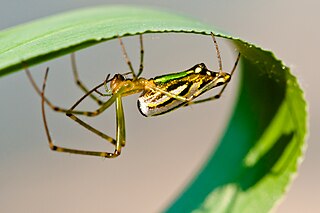
Leucauge decorata, the decorative silver orb spider, is one of the long-jawed orb weaver spiders. A medium to large sized orb weaving spider, with a body length up to 12 mm long (female). Male to 6 mm. This species has a "point" to the end of the abdomen. Found in Africa, India, south east Asia, also to Australia.

Gasteracantha hecata is a species of spider in the spiny orb-weaver genus Gasteracantha. It occurs in the Philippines and has prominent horn-like spines on its abdomen.


















